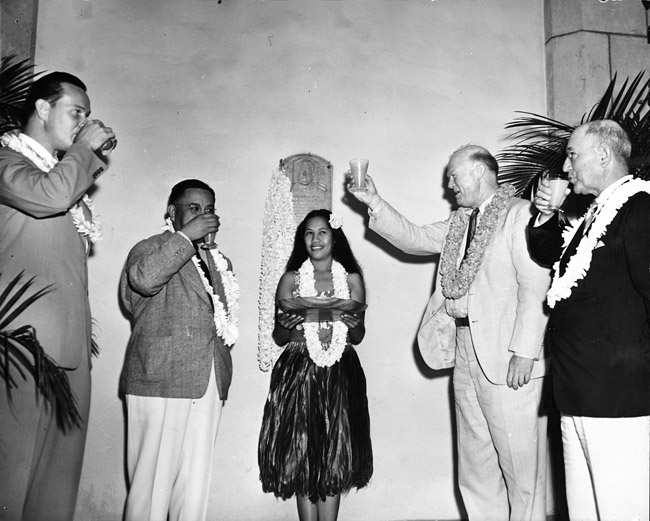Tracking Down Cartwright’s Plaque

This photo from Aug. 26, 1939, honors Alexander Joy Cartwright Jr. on Cartwright Day across Major League Baseball. (left to right) W.E. Cartwright Jr. (Alexander’s great-grandson), Acting Mayor David Y.K. Akana, hula girl Pualani Notley, A.L. Castle leading the toast and A. Lewis Jr. Photo from Hall of Fame Archives
About an hour north of New York City along the Hudson River, and three hours southeast of Baseball’s Hall of Fame site in Cooperstown, along Highway 9 and just off the appropriately named Diamond Hill Road in Garrison, N.Y., sits a sports bar and restaurant called The Stadium. For sports fans, it’s a must-see destination. For editor Don Chapman and me at MidWeek, it’s the answer to part of a mystery and more.
“If I were rating this place as a sports museum, it would get five stars,” writes one reviewer of The Stadium. “It has an amazing amount of memorabilia.”
Among the hordes of great sports stuff, you’ll see Babe Ruth’s first contract, the original Heisman Trophy, Mickey Mantle’s Triple Crown Trophy, Patrick Ewing’s game shoes, Wayne Gretzky’s hockey stick, a Cy Young Award or two, several MVP trophies, tons of autographed photos … and the duplicate Hall of Fame plaque for Hawaii’s Alexander Joy Cartwright Jr., the “Father of Modern Baseball.”
The journey to finding out about The Stadium began with a series of emails Don and I received from Pearl City’s Jon Arakaki, a college professor who now works and lives in upstate New York. Arakaki volunteers part-time at the Hall of Fame in Cooperstown and recently came across a photo depicting the Cartwright plaque from a 1939 Honolulu newspaper.
Subsequent research found that the photo included Cartwright’s great-grandson, as well as Honolulu’s interim mayor, and the chair and vice-chair of baseball’s Centennial Committee (in which Honolulu played an interesting part), all toasting with cups of pineapple juice in front of the Cartwright plaque that was ultimately placed at Honolulu City Hall. The date was Aug. 26, 1939, known as Cartwright Day across Major League Baseball, when similar pineapple juice toasts were made to honor the man who wrote down the rules of baseball in New York City in 1845 and the next year founded the first team and organized the first game in Hoboken, N.J. As Don details in his 2002 book, The Ball That Changed the World: The Story ofAlexander Joy Cartwright Jr., True Father of Baseball, Cartwright joined the 1849 Gold Rush and upon arriving in San Francisco kept going west, becoming a major citizen of Honolulu in the second half of the 19th century (including helping to found our fire department and first library).
His replica plaque hung at City Hall for more than five decades before the Cartwright family apparently asked someone to take it down and return it to them.
This is where the story gets murky, as it’s uncertain if the family was upset with how the plaque had been displayed or whether they wanted it in Hoboken, or just what the problem was. In any case, the plaque left Hawaii, never making it to New Jersey, and was subsequently sold.
No one is quite sure how it specifically made its way to its current location, but the best guess is that it was auctioned by the memorabilia website Sotheby’s for a price of about $13,000, according to old newspaper archives.
“I wonder what kind of prominence it had in our City Hall,” Arakaki laments. “It sure would be nice to see it back in Hawaii, or somewhere it could be displayed more prominently with the story of Alexander Joy Cartwright Jr.”
In the meantime, as all of these emails were going back and forth, Jon inquired about Don’s Cartwright book, which he knew he’d been working on. Finding it was published, he suggested sending a copy to the Hall. Jon subsequently emailed Don that his 1995 book on the Hawaii Winter Baseball League, Boys of Winter, was already in the Hall’s Research Library.
Jon confirms that both Don’s books are now in the Hall. How neat is that?
Next step: Discovering more about the Cartwright plaque story. Perhaps you can help us solve the mystery. If you know anything more about its display at Honolulu’s City Hall or why/how it left, feel free to contact me at the address below.





